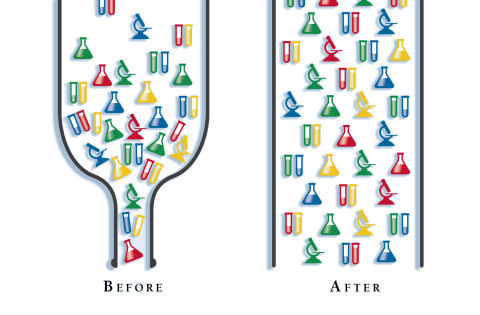In Context: Patients as the Bottleneck
“The bottleneck is actually the patient,” Dough Hirsch, CEO of GoodRx, said on a panel at the Health 2.0 Conference last week.
Hirsch, speaking really quickly, explained why it’s so difficult to get a health care startup off the ground. If you sneezed, you would have missed the quote. But if you were on Twitter, you saw it tweeted and retweeted along with angry reactions.
The health care system is messy and doesn’t work well for many, many people. Entrepreneurs are only just starting to scratch the surface when it comes to discovering ways to use the web and mobile devices to improve patient care.
The last thing you want to do as a startup founder is disparage your potential customers because they don’t want to use what you’ve created. The customer is always right.
But I don’t think Hirsch was blaming the customer. On Twitter, the quote was taken out of context.
“Just because you can build it doesn’t mean the patient is going to take advantage of it,” Hirsch continued. “A lot times we presuppose things that patients would do that patients actually don’t want to do or aren’t motivated to do.”
Hirsch said he’s always wondering if what he’s asking people do is something he would do himself.
That explanation didn’t appear on Twitter. However, an interesting, and pretty constructive, followup conversation inspired by the “bottleneck” soundbite did.
Hirsch is considered a veteran in this still very new space. Before co-founding GoodRx, he founded Dailystrength, an online site for people facing health and life challenges. I followed up with Hirsch and asked him to elaborate on the quote:
What I meant to say was that it can be very hard to change existing patient (and just plain human) behavior. I’ve seen many new products come and go in my years of working in Health IT, and many of these products expected a change in patient behavior which was simply unrealistic. Just because you build a fancy new tracking mechanism for weight loss or a gadget you can wear 24/7 doesn’t mean patients will jump out of their chairs to begin using them and make a meaningful difference in their health. Old habits die hard.
So like I said! He’s not blaming patients.
Wait … there’s more:
I also see challenges in patient expectations versus reality. I think we all (and I include myself in that bucket) have expectations of the health care system which need to change. We’re seeing a surge of innovation (for better or worse) on the government side, at the doctor’s office and even with insurance companies, but how will patients innovate?
At GoodRx, we’re testing that thesis right now by providing price transparency for prescription drugs for patients who are motivated enough to try out our product. Early returns look good, but ultimately time will tell how much change patients are ready to swallow.
According to Hirsch, there is a place for patient responsibility.
He’s right. Let’s agree that there’s a long list of obstacles we face in improving health care. Sometimes, the obstacle is the patient who refuses behavior change, and sometimes it’s the presumptuous entrepreneur. The important thing is that one group knows that the other plays an important role in the shared goal of improving care.





 Idea for a guest post? Get in
Idea for a guest post? Get in